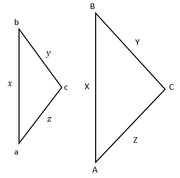AAPL wrote:
In the figure above, triangle abc is similar to triangle ABC. X, Y, Z and x, y, z represent the sides of each similar triangle. If the area of triangle ABC is twice the area of triangle abc, which of the following expresses X in terms of x?
$$A.\ \ \frac{x}{\sqrt{2}}$$
$$B.\ \ x\sqrt{2}$$
$$C.\ \ \frac{x}{2}$$
$$D.\ \ 2x$$
$$E.\ \ 4x$$
The OA is
B.
Please, can any expert assist me with this PS question? I don't have it clear and I appreciate if any explain it for me. Thanks.
Think of a very simple case in which one triangle has twice the area of another, and the triangles are similar.
Triangle One: Base = 2 and Height. = 2. Area = 2*2/2 = 2. (Effectively, we're setting x = 2, and arbitrarily picking an equal height to make the calculation simple. It doesn't matter what the height is, so long as the ratio between base and height is the same for the two similar triangles)
So we know that Triangle Two will have 1/2 the area of 2, or 1. If the base and height are equal, then we know that b*h/2 = 1. So b*b/2 =1, or b^2 = 1/2, and b = 1/√2 and h = 1/√2.
To summarize: base of triangle One = 2; base of triangle Two = 1/√2. Ratio of the sides = 2/1/√2 = 2√2. In other words, we can find the ratio by taking a side of the larger triangle, 2, and multiplying it by √2, to get 2√2. So if the initial base were x, the ratio would be x√2, or
B



















